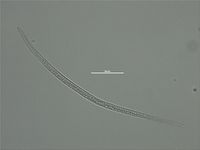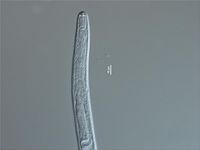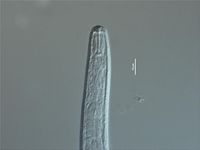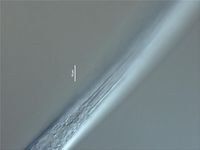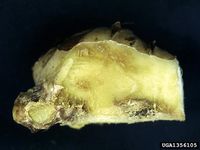Radopholus similis
| Literature database |
|---|
| 208 articles sorted by: |
| • year (descending) |
| • research topics |
| • countries/regions |
| • host plants |
| • list of antagonists |
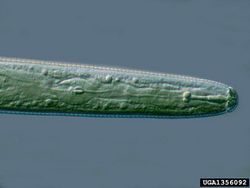
Author: Roger Lopez-Chaves, Universidad de Costa Rica
Source: IPM IMAGES
Radopholus similis (Cobb, 1893) - (burrowing nematode)
The nematode is wide-spread in tropical and subtropical regions, causing important diseases like toppling disease of banana, spreading decline of citrus or diseases of pepper and ornamentals. Other crops may also become parasitized. Roots are infested, develop necrotic lesions and die off, causing stunting and yield losses. In bananas, roots and corms are attacked. Large populations result in a weakened root system and banana trees falling down (toppling) during strong winds. Infestations of citrus roots cause canopy thinning, retarded terminal growth, twig dieback and substantial yield losses, often exceeding 50%.
The species is an endoparasitic migratory nematode. The juveniles and females penetrate the roots and then migrate within the root tissue. Females lay their eggs inside the root or in the soil. The juveniles hatch from the eggs as J2. Inside the roots, they either continue their life cycle or leave the root in search for another host. The life cycle may be completed in about 3 weeks. Management involves the use of nematicides or hot water treatment of seedlings.
| Vernacular names | |
|---|---|
| • English: | banana-root nematode burrowing nematode |
| • Français: | anguillule mineuse du bananier |
| • Português: | nematoide cavernícola |
The adult males are around 500-600 µm long, the females 600-800 µm. Both male and female have long, tapered tails with rounded or indented ends. The stylet of males is reduced, while that of females is about 18 µm long, robust and bears three distinct knobs. The females have flattened lips and a vulva slightly distal of the middle of the body.
Synonyms:
Radopholus citrophilus
- Other images of Radopholus similis (IPM Images and PaDIL - click to enlarge)

